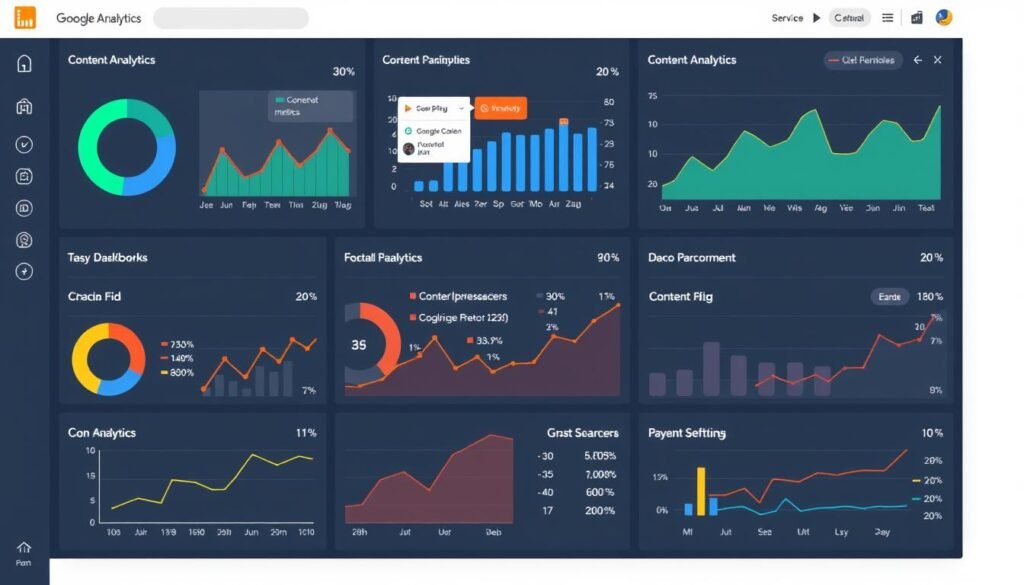Today’s buyers are increasingly going online to find their next professional services partner, making a digital content marketing strategy crucial for businesses.
A well-planned strategy helps you create and distribute valuable content to reach new audiences, build credibility, and generate leads.
This comprehensive guide will walk you through the process of creating and implementing an effective marketing strategy in today’s rapidly evolving digital landscape.
By the end of this guide, you’ll have a clear roadmap for developing a strategy that drives real business results.
Key Takeaways
- Understand the importance of digital content in modern marketing.
- Learn how to create a comprehensive content marketing strategy.
- Discover ways to leverage content to connect with your target audience.
- Explore the fundamental principles of successful content marketing.
- Develop a clear roadmap for implementing your content marketing strategy.
Understanding the Digital Content Landscape
To stay ahead in the market, it’s essential to comprehend the current state of digital content marketing. The digital landscape has transformed the way businesses interact with their customers, making content a crucial element in any marketing strategy.
Today, almost 70 percent of buyers say they use digital channels to research their business problems. This shift in consumer behavior has significant implications for companies offering professional services.
The Evolution of Digital Content Marketing
Digital content marketing has evolved significantly over the years. It has become the primary touchpoint between businesses and their potential customers. Most buyer journeys now begin with online research, highlighting the importance of having a robust digital presence.
- Studies show that approximately 70% of buyers use digital channels to research business problems before making purchasing decisions.
- Quality content establishes your brand as an authority in your industry, building trust with potential customers.
Why Digital Content Matters in Today’s Market
In today’s market, digital content is more than just a marketing tool; it’s a necessity. Companies with strong digital content strategies typically see higher conversion rates, shorter sales cycles, and improved customer retention.
- Unlike traditional advertising, digital content continues working for your business 24/7, generating leads and building brand awareness.
- The data-driven nature of digital content enables companies to continuously refine their approach based on real-time performance metrics.
Defining Your Digital Content Strategy

To stand out in a crowded digital space, businesses must develop a clear and effective content strategy. The key to a successful online presence lies in creating a robust digital content strategy that resonates with your target audience. A well-crafted strategy not only enhances your brand’s visibility but also drives engagement and conversion.
Setting Clear Business Goals
Your digital content strategy should start with clear business goals. What do you aim to achieve through your content marketing efforts? Whether it’s increasing brand awareness, generating leads, or driving sales, your goals will guide the type of content you create and how you distribute it. For instance, if your goal is to establish your company as a thought leader in your industry, you may focus on creating in-depth, informative content that addresses the needs and pain points of your audience.
Identifying Your Target Audience
Understanding your target audience is crucial for creating content that resonates. You need to know their preferences, pain points, and behaviors to develop a content strategy that speaks to them. Data plays a significant role here; analyzing your audience’s online behavior and feedback can provide valuable insights into what type of content they engage with.
Researching Your Competition
Competitive research is essential for identifying content gaps and opportunities that can differentiate your brand. Analyze your competitors’ content strategies by examining their blog topics, content formats, publishing frequency, and distribution channels. Use SEO tools to identify which keywords your competitors are ranking for and where there might be opportunities for your content to gain visibility. Some key aspects to consider include:
- Evaluating the quality, depth, and presentation of competitor content to understand what’s working in your industry.
- Looking for topics that competitors have overlooked or areas where existing content doesn’t adequately address customer questions and pain points.
- Paying attention to engagement metrics on competitors’ social media posts and content to identify what resonates with your shared audience.
By following these steps, you can develop a comprehensive digital content strategy that not only aligns with your business goals but also resonates with your target audience and sets you apart from the competition.
Types of Marketing Digital Content

To effectively engage your audience, you need to be familiar with the diverse types of digital content at your disposal. The digital landscape offers a wide array of content formats, each with its unique strengths and purposes. By understanding and leveraging these different types, you can create a comprehensive content marketing strategy that resonates with your target audience and drives meaningful results.
Blog Posts and Articles
Blog posts and articles remain cornerstone elements of digital content marketing. They provide valuable information to your audience, establishing your brand as a thought leader in your industry. By optimizing your blog posts with relevant keywords, you can improve your search engine rankings and attract more leads. For more insights on creating effective blog content, you can learn more about types of digital.
Videos and Podcasts
Videos and podcasts offer engaging ways to convey complex information in an easily digestible format. These content types allow you to connect with your audience on a deeper level, fostering a more personal connection. By incorporating videos and podcasts into your content strategy, you can cater to different learning preferences and increase audience engagement.
Social Media Content
Social media content is crucial for maintaining an active online presence. It enables you to interact with your audience in real-time, share updates, and promote your brand. Effective social media content can drive traffic to your website, generate leads, and enhance your brand’s visibility. By tailoring your content to each social media platform, you can maximize your reach and impact.
Premium Content: Ebooks, Guides, and Webinars
Premium content, such as ebooks, guides, and webinars, provides substantial value to your audience. These longer-format content pieces allow you to delve deeper into topics, establishing your brand as a definitive resource. By offering premium content in exchange for contact information, you can generate high-quality leads and nurture them through your marketing funnel. Examples of premium content include executive guides, research reports, white papers, demos, courses, and tutorials.
Essential Digital Marketing Channels

Effective digital marketing hinges on leveraging the right channels to reach and engage your target audience. With numerous options available, understanding the strengths of each channel is crucial for a successful strategy.
Content Marketing Platforms
Content marketing platforms are vital for hosting and distributing your content. They help in establishing your brand as a thought leader in the industry. By creating valuable and relevant content, you can attract and retain a clearly defined audience.
Email Marketing
Email marketing remains one of the most effective digital marketing channels. It allows for direct communication with your audience, enabling personalized messaging and nurturing leads. With the right strategy, email marketing can drive conversions and foster customer loyalty.
Social Media Platforms
Social media platforms are indispensable for expanding your reach and engaging with your audience. They offer a unique opportunity to build brand awareness, share content, and interact with customers in real-time. By leveraging social media effectively, you can drive traffic to your website and generate leads.
Search Engines
Search engines are a primary source of online traffic, making search engine optimization (SEO) a critical component of your digital marketing strategy. By optimizing your content for search engines, you can improve your visibility, drive organic traffic, and reach potential customers actively searching for your services or products.
Creating Compelling Digital Content

In the world of digital marketing, content is king, but only if it’s crafted with your audience’s needs in mind. To create compelling digital content, you must first understand what drives your audience and tailor your strategy accordingly.
Understanding Your Audience’s Needs
To create content that resonates, you need to know what your audience is looking for. Analyzing your content marketing analytics can reveal a lot about your customers: what they’re looking for when they land on your site, what kinds of content make them stay longer, and what makes them lose interest. By understanding these insights, you can tailor your content to meet their needs effectively.
Developing a Unique Voice and Style
Your brand’s voice and style are crucial in making your content stand out. Developing a unique tone that reflects your brand’s personality helps in building a consistent and recognizable identity across all your marketing channels. This uniqueness is what will keep your audience engaged and coming back for more.
Incorporating SEO Best Practices
For your content to be seen by your target audience, it needs to be optimized for search engines. This involves using relevant keywords strategically, such as content and marketing, throughout your content. For more insights on optimizing your content for SEO, check out tips from Forbes on writing compelling content that’s optimized for SEO.
Creating Content That Converts
Conversion-focused content is designed to guide readers toward taking specific actions that advance them through your marketing and sales funnel. Effective calls-to-action (CTAs) are clear, compelling, and aligned with both the content topic and where the reader is in their buyer’s journey. Some key strategies include:
- Strategic content mapping to ensure appropriate content for each stage of the buyer’s journey.
- Incorporating social proof elements like testimonials and case studies to build trust.
- A/B testing different content formats and CTAs to identify what drives the highest conversion rates.
By implementing these strategies, you can significantly improve your content’s ability to generate leads and conversions.
Building an Effective Content Calendar
To streamline your content marketing efforts, developing an effective content calendar is essential. This involves planning your content strategy and selecting the right tools for managing your calendar.
Planning Your Content Strategy
Planning your content strategy is the first step in creating an effective content calendar. This involves setting clear goals for your content marketing efforts and understanding your target audience. By doing so, you can create content that resonates with your audience and aligns with your business objectives.
Key considerations include identifying the types of content that work best for your audience, deciding on the frequency of your content publication, and ensuring that your content aligns with your overall marketing strategy.
Tools for Content Calendar Management
The right content calendar tools can significantly streamline your planning, production, and publication processes. They also improve team collaboration and accountability.
- Simple solutions like Google Sheets or Excel can work well for small teams.
- Project management tools like Asana, Trello, or Monday.com offer visual workflows.
- Editorial calendar plugins for WordPress and other CMS platforms can integrate directly with your website.
- Content marketing platforms like CoSchedule, Contently, or Kapost combine calendar functionality with workflow management and performance analytics.
When selecting a tool, look for features like task assignment, status tracking, and integration with your publication platforms. The best tool is one that your team will actually use consistently.

Measuring Digital Content Success
The key to maximizing your digital content’s impact lies in accurately measuring its performance and adjusting your approach as needed. To achieve this, you must have a clear understanding of the metrics that matter most to your content’s success.
Key Performance Indicators (KPIs) to Track
To effectively measure the success of your digital content, you need to identify and track the right KPIs. These may include metrics such as engagement rates, click-through rates, conversion rates, and return on investment (ROI). By monitoring these KPIs, you can gain valuable insights into how your content is performing and make data-driven decisions to improve its effectiveness.
Some of the key KPIs to track include:
- Data-driven content optimization is an ongoing process of testing, learning, and refining based on performance metrics and audience feedback.
- Regular content audits help identify your highest and lowest performing pieces, revealing patterns that can inform future content creation.
- A/B testing different content elements—headlines, formats, CTAs, publishing times—provides concrete data on what resonates best with your audience.
- Content gap analysis using search and competitive data helps identify topics your audience is interested in that you haven’t yet addressed.
Analytics Tools for Content Measurement
To track your KPIs and gain a deeper understanding of your content’s performance, you need to leverage the right analytics tools. Some popular options include Google Analytics, SEMrush, and Ahrefs. These tools provide valuable insights into your content’s performance, helping you to refine your strategy and improve your results over time.

Using Data to Refine Your Strategy
Having good, accurate analytics and the know-how to interpret them can help marketers “fail fast,” quickly cutting campaigns that aren’t working and building better campaigns around concepts that have a proven track record of success. By regularly reviewing your content’s performance data, you can identify areas for improvement and refine your strategy to achieve better results.
Some key strategies for using data to refine your content strategy include:
- Performance trends over time can reveal seasonal patterns or changing audience preferences that should influence your content calendar.
- Conversion path analysis shows which content pieces most effectively move prospects through your marketing funnel toward becoming customers.
- Qualitative feedback from comments, customer service interactions, and sales conversations should complement quantitative data in refining your strategy.
- Creating a regular review cycle ensures insights are actually implemented rather than just collected and forgotten.
Advanced Digital Content Marketing Strategies
As you continue to navigate the ever-evolving digital landscape, it’s essential to stay ahead of the curve with advanced digital content marketing strategies. The digital content sphere is becoming increasingly competitive, and leveraging sophisticated techniques is crucial for standing out and achieving your marketing goals.
Content Personalization
Content personalization involves tailoring your content to meet the specific needs and preferences of your audience. By using data-driven insights, you can create personalized experiences that resonate with your audience and drive engagement. Personalization engines use AI to deliver customized content based on user behavior and preferences at scale.
Leveraging User-Generated Content
User-generated content (UGC) is a powerful tool for building trust and credibility with your audience. By encouraging your customers to share their experiences and content related to your brand, you can create a wealth of authentic and engaging content. UGC not only enhances your content offerings but also fosters a sense of community around your brand.
Repurposing Content Across Channels
Repurposing content is an effective way to maximize your content’s reach and impact. By adapting your content for different channels and formats, you can ensure that your message is conveyed consistently across various platforms. This strategy not only saves time but also helps in maintaining a cohesive brand voice.
Integrating AI in Content Creation
The integration of AI in content creation is transforming the way businesses approach content marketing. AI tools can automate routine tasks, generate draft content, and provide data-driven optimization suggestions. However, it’s crucial to maintain human oversight to ensure that AI-generated content aligns with your brand values and adheres to ethical standards.
By embracing these advanced digital content marketing strategies, you can elevate your content game and stay ahead in the competitive digital landscape. Remember to stay updated with the latest tools and technologies to continually refine your content strategy.
Common Digital Content Marketing Challenges
As you navigate the complex world of digital content marketing, you’re likely to encounter several challenges that can hinder your progress. Content marketing is about building a sustainable, trusting relationship with your customers that can potentially lead to many sales over time, not just a single transaction.
One of the primary difficulties marketers face is maintaining consistency in their content publication schedule. Regular content publication helps maintain audience engagement and improves search visibility, but it can be challenging to sustain this consistency, especially with limited resources.
Maintaining Consistency
To maintain consistency, you need to plan your content strategy effectively. This involves creating a content calendar that outlines what content will be published and when. By doing so, you can ensure that your audience remains engaged and that your content continues to attract new readers.
Standing Out in a Crowded Market
Another significant challenge is standing out in a crowded market. With so much content being produced daily, it can be difficult to make your voice heard. To overcome this, focus on creating high-quality, unique content that resonates with your target audience. For more insights on overcoming content marketing challenges, visit Coredna’s blog on content marketing challenges.
Balancing Quality and Quantity
Finding the right balance between content quality and quantity is a persistent challenge for marketing teams. High-quality content typically generates better engagement, conversions, and long-term value. However, producing high-quality content requires more time and resources. Strategic content planning can help identify where to invest in comprehensive pieces versus simpler formats.
Conclusion: Taking Your Digital Content Marketing to the Next Level
The journey to mastering digital content marketing is ongoing, requiring consistent effort and adaptation. To achieve sustainable marketing success, it’s crucial to build a comprehensive content strategy that aligns with your business goals.
Successful content marketing involves continuous experimentation, measurement, and refinement. By investing in the right mix of content types, channels, and promotion strategies, you can create a balanced approach that reaches your audience at every stage of their journey. As search engine optimization and social media algorithms evolve, focusing on creating genuinely valuable content remains the most future-proof strategy.
To maximize the impact of your content marketing efforts on overall business results, integrate them with other business functions, from sales to customer service. For long-term success, building internal capabilities and processes for content creation and management is just as important as the content itself. For more insights on optimizing your online presence, consider exploring resources on how to choose a web hosting provider with good security, which can be a critical aspect of your overall marketing strategy and achieving desired results.
